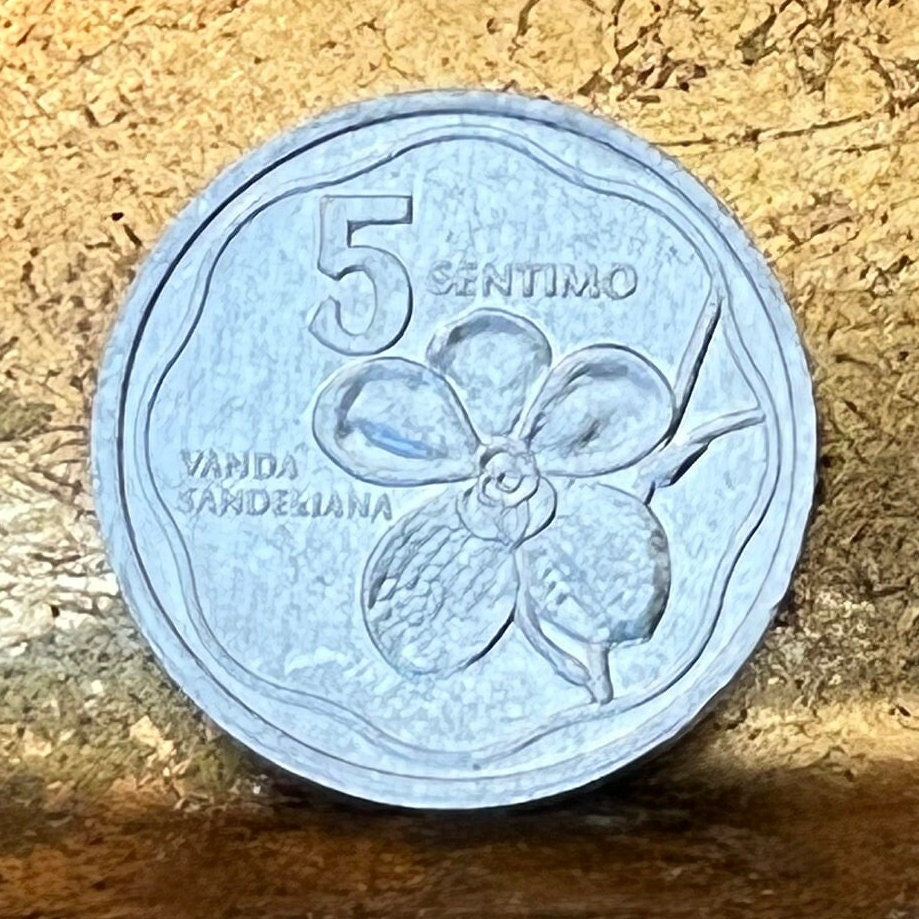elemintalshop
Mother of Revolution Melchora Aquino & Waling-Waling Orchid 5 Sentimo Philippines Authentic Coin Money for Jewelry (Queen of Flowers)
Mother of Revolution Melchora Aquino & Waling-Waling Orchid 5 Sentimo Philippines Authentic Coin Money for Jewelry (Queen of Flowers)
Couldn't load pickup availability
Mother of Revolution Melchora Aquino & Waling-Waling Orchid 5 Sentimo Philippines Authentic Coin Money for Jewelry and Craft Making (Tandang Sora) (Queen of Philippine Flowers)
Obverse: Melchora Aquino
Lettering: REPUBLIKA NG PILIPINAS
MELCHORA
AQUINO
Reverse: Waling-Waling orchid (scientific name: vanda sanderiana)
Lettering:5 SENTIMO
VANDA
SANDERIANA
Features
Issuer Philippines
Period Republic (1946-date)
Type Standard circulation coin
Years 1983-1992
Value 5 Sentimo (0.05 PHP)
Currency Piso (1967-date)
Composition Aluminium
Weight 1.2 g
Diameter 17 mm
Thickness 2.08 mm
Shape Round
Technique Milled
Orientation Medal alignment ↑↑
Demonetized 2 January 1998
Number N# 2463
References KM# 239, Schön# 80
WIkipedia:
Melchora Aquino de Ramos (January 6, 1812 – February 19, 1919) was a Filipina revolutionary who became known as "Tandang Sora" ("Elder Sora") because of her age during the Philippine Revolution.
She was known as the "Grand Woman of the Revolution" and the "Mother of Balintawak" for her contributions.
Early life and marriage
Tandang Sora or known as the "Mother of Revolution" was born on January 6, 1812 in Barrio Banlat, Caloocan (the present-day Barangay Tandang Sora, Quezon City).
Tandang Sora, daughter of a peasant couple, Juan and Valentina Aquino, never attended school. However, she was apparently literate at an early age and talented as a singer and performed at local events as well as at Mass for her Church. She was also often chosen for the role of Reyna Elena during the "Santacruzan", a processional pageant commemorating Empress Helen's finding of the Cross of Christ, celebrated in the Philippines in May.
Later in life, she married Fulgencio Ramos, a cabeza de barrio (village chief), and bore six children. Ramos died when their youngest child was seven and she was left as a single parent for their children. Tandang Sora continued her life as an hermana mayor active in celebrating fiestas, baptisms, and weddings. She worked hard in order to give her children education.
Involvement in the revolution
In her native town, Tandang Sora operated a store, which became a refuge for the sick and wounded revolutionaries. She fed, gave medical attention to and encouraged the revolutionaries with motherly advice and prayers.
Secret meetings of the Katipuneros (revolutionaries) were also held at her house. Thus she earned the names "Woman of Revolution", "Mother of Balintawak", "Mother of the Philippine Revolution", and Tandang Sora (Tandang is derived from the Tagalog word matandâ, which means old). She and her son, Juan Ramon, were present in the Cry of Balintawak and were witnesses to the tearing up of the cedulas.
When the Spaniards learned about her activities and her knowledge to the whereabouts of the Katipuneros, she was interrogated but she refused to divulge any information. She was then arrested by the guardia civil and was deported to Guam, Marianas Islands, where she and a woman named Segunda Puentes were placed under house arrest in the residence of a Don Justo Dungca.
After the United States took control of the Philippines in 1898, Tandang Sora, like other exiles, returned to the Philippines in 1903. She died at her daughter Saturnina's house in Banlat on February 19, 1919 at the age of 107. Her remains were first interred at the Mausoleum of the Veterans of the Revolution at the Manila North Cemetery. These were then transferred to the Himlayang Pilipino Memorial Park in Quezon City in 1970 and finally at the Tandang Sora National Shrine in 2012.
*******
Wikipedia:
Vanda sanderiana is a flower of the orchid family. It is commonly called Waling-waling in the Philippines and is also called Sander's Vanda, after Henry Frederick Conrad Sander, a noted orchidologist. The orchid is considered to be the "Queen of Philippine flowers" and is worshiped as a diwata by the indigenous Bagobo people.
Heinrich Gustav Reichenbach named it as Vanda sanderiana.
It has two forms, pink and white, also referred to as alba. M. Roebelin discovered the original pink variety in the Philippines in 1881 or 1882. Rudolf Schlechter separated Euanthe from Vanda in 1914 due to structural differences in the flowers. For breeding purposes and registration by the Royal Horticultural Society, however, it is still treated as a Vanda.
Vanda sanderiana is endemic to Mindanao in the provinces of Davao, Cotabato, and Zamboanga where it is found on the trunks of dipterocarp trees at elevations below 500 meters. Over-collected, the plant is considered rare in nature. It is often used in hybridization.
Studies have shown that when raised at high altitude, the plant bears flowers early.
In 2004, a motion was filed in the House of Representatives of the Philippines to declare the Waling-waling as the country's national flower, replacing the Sampaguita.
In 2013, a bill was passed by the Philippine Senate declaring the Waling-waling as a national flower alongside the Sampaguita. However, the House Bill 5655 was vetoed by President Benigno Aquino III citing that other means were available to promote the protection and preservation of the orchid without declaring it a second national flower.
Share










Mother's Day Present! Mother of the REVOLUTION! My ma loved it. Thanks









